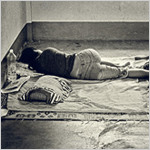|
|
|
|
|
|
|
|||
|
|
|||
Disclaimer: The news story on this page is the copyright of the cited publication. This has been reproduced here for visitors to review, comment on and discuss. This is in keeping with the principle of 'fair dealing' or 'fair use'. Visitors may click on the publication name, in the news story, to visit the original article as it appears on the publication's website.
 Article from
IRIN
Article from
IRIN
Author: IRIN Staff
Published: 20/05/2009
Newspaper section: Health & Nutrition
The controversy surrounding the trial this month of a British woman by Lao courts for alleged drug trafficking has focused attention on drug use and treatment in the country.
Once a world leader in opium production and still a major transit route for the drug, heroin smugglers can face life imprisonment or even execution in Laos.
But today, this impoverished nation's criminal system is struggling to cope with a new drug "yabaa" - literally "crazy drug" in Lao, one of the amphetamine-type substances (ATS) family, which includes amphetamines and methamphetamines.
It is threatening overstretched resources as an increasing number of the country's youth becomes addicted and has overtaken heroin as the drug of choice, largely due to the government's successful opium-eradication policy. Yabaa is easy to obtain, relatively cheap at less than US$1 a hit, available countrywide, and highly addictive.
Once limited to urban areas, yabaa abuse has spread to rural areas and affects every strata of society.
According to the UN Office on Drugs and Crime (UNODC), in a country of roughly six million people, Laos now has 40,000 ATS users - a 14 percent increase on 2006.
With little support to help people break their drug habits, affected families turn to extreme measures to deal with addicts - stories of drug users being chained up are not unheard of but more often than not, when things get completely out of hand, many ask the local militia to take the user to the lock-up.
"It's not that they don't love their children. They're doing the best they can," said Leik Boonwaat, country representative for UNODC Lao PDR, "but the government lacks sufficient resources to deal [with the problem]."
As a result, the government is trying out a new approach, which focuses on rehabilitation rather than punishment and incarceration.
Transforming the system
Somsanga Treatment and Rehabilitation Centre in Vientiane Capital was set up as a drug enforcement facility in 1996. Previously run by the Ministry of Public Security, the government turned it over to the Ministry of Health five years ago.
The new director, Sisouphanh Boupha, has introduced many changes. The aim now, he says, is to cure drug users of their habit and help reintegrate them into society so they do not return to a life of drugs and crime.
"Before I first arrived, the patients were treated like prisoners. The atmosphere was terrible. The patients did detoxification themselves. There were no activities to occupy them and they kept returning. Now we have a process: detoxification; rehabilitation, including counselling, vocational and occupational training activities; and reintegration," he explained.
Occupational activities are the key, says Stefan Wetzel, UNODC vocational and occupational activities programme coordinator.
"ATS users lose the ability to feel pleasure through any means other than ATS. We have to provide them with an alternative before they can find pleasure in anything else and are able to learn new skills," he explains.
Sports, films and a gym have been introduced and families are invited to the centre to participate - a remarkable change in a system famous for its secrecy. "Families see that we treat their relatives well and start trusting us so they support their rehabilitation and reintegration," said Sisouphanh.
Vocational training not only entertains patients but provides them with confidence and skills for their return to the outside world. Printing, cooking, computer and English training are offered; printers and chefs make a little pocket money from the sale of food to local restaurants and T-shirts to UNODC.
Tuk Lathda is at Somsanga for the second time. She was sent here both times by her family after "causing big problems at home" with her drug use. Vocational training was not offered when she came the first time. This time she has learnt to cook. "I already have a cooking job lined up for when I leave," she says.
Replicating the model
If successful, the government hopes to take the Somsanga model to seven other drug centres in the country.
But there are still problems: the centre lacks adequate basic sanitation and hygiene; it was built to house 500 but at the time of IRIN's visit it held around 750; children, some younger than 10, are housed with adults.
But just as big a challenge, says UNODC's Boonwaat, is tackling the factors leading young people to Somsanga in the first place.
"Fifty percent of the population is under 20. The most at-risk group for ATS use is 12-19, which represents 1.4 million people. We've made many significant changes in Somsanga. The patients are more confident. They aren't treated badly. And the government is more transparent as a result. But it needs to invest in youth because there aren't many jobs and it will only get worse - then [drug abuse] will too," he explained.